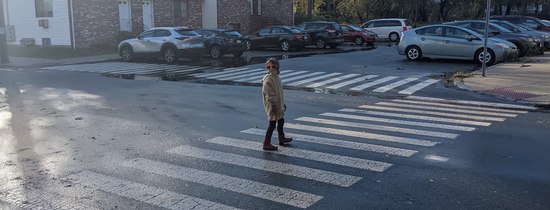Teaching Street Crossing |
January 16th, 2022 |
| kids |
Unfortunately, she took looking both ways to be about pointing her head, not about actually looking. She would wiggle her head as fast as possible, trying to maximize how many times she could look left and right, much faster than she could actually tell what she was seeing. (Lily: "when I first started learning how to cross streets I would turn my head like a maniac.") This was not useful practice, and after trying and failing to show her how to look I decided to wait until she was older. After a while I stopped bringing up the idea, she stopped bringing it up, and this was on hold for a couple years.
This summer, when Lily was seven and Anna was five, we tried again. This time it went much better: they would both actually look for cars, and would see them when they were coming. Pretty quickly we got to where we would do this with most streets: I would ask whether they wanted to practice, and they would cross on their own with me checking that they were doing it right. On streets with parked cars, I taught them to slow down and look again after they got to the "car line". This is the point about 6 feet from the curb where sightlines are no longer blocked by parked cars.
Over the next few weeks with lots of walks together they were both, but especially Lily, reliably doing it right. I started giving them permission when they had gone ahead of me, to where I could see them and tell whether they were looking properly, but couldn't see everything they could see. By September (7y5m) Lily was almost ready to do it on her own, and in October she was ready for a set of small streets near our house. We used walkie-talkies, and she would check in with us over the radio before crossing and after to let me know it went ok. Lily could walk places herself, and could bring Anna if they both wanted that.
The biggest street they wanted to cross but couldn't was a busy one between our house and the closest playground. I was expecting it was going to be a year or two yet, but then in November the city put in several serious "speed humps". Traffic slowed down dramatically, enough that I thought Lily could do it. I did the same thing as before, watching her many times to check her work, but by the end of the month she had demonstrated she could do it safely.
(Anna overheard me dictating this post, and asked whether we could do more practice so that she could get to crossing streets on her own. Looking forward to running through this a second time!)
I asked Lily what she saw as the main benefit of being able to cross streets, and she said "I'm able to go to friends houses without having a grown-up available." I asked if she had anything she wanted to tell parents or other kids, and she said "it's tricky at first but over time you get better at it and you get more responsibility."
In many ways, this was the same process we used in teaching them to stop at the curb: slowly increase responsibility while continuing to verify they're doing it safely. It does require concentrated parental time and attention, and slows down walks, but now they can go and visit friends entirely on their own which frees up parental time later. I think the payback period is under a year if you think of it that way, but that's not counting the benefit of them having more freedom in how and where they spend their time.
Comment via: facebook, lesswrong, substack
